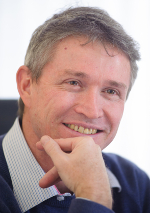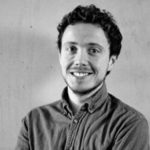
Monika Adelsberger
Monika Aidelsburger is a research group leader in the Quantum Optics group at LMU Munich, where she also graduated and received her PhD. In the group of Prof. I. Bloch she worked on the engineering of artificial magnetic fields and topological band structures with ultracold atoms in optical lattices. Here main contribution to the field is the realization of the Hofstadter model and the measurement of bulk topological properties via transport experiments. After her PhD she moved to France for a PostDoc in the group of Prof. J. Dalibard, where she worked on homogeneous 2D Bose gases. Now back in Munich, her main research interests are topological many-body physics and lattice gauge theories.

Andreas Aumann
Andreas is currently Vice President Product Management BMW i, eMobility at BMW. He started his career with a PhD in experimental physics at Westfälische Wilhelms-Universität Münster, Germany. He has worked in industry as a technical lead, director and a consultant before joining BMW. While working for BMW he has worked in Europe and in China.

Peter Barker
Peter Barker studied at the University of Queensland in Australia and did his PhD in the group of Halina Rubinsetin Dunlop (1996). He spent four years as a Postdoc at Princeton University in the US before starting work as a Lecturer in Physics at Heriot-Watt University in the UK. For the last 12 years he has led experiments on cold molecules and nanoparticles and their manipulation via optical fields. More recently, he has explored the cooling of levitated nanoparticles in optical and electrical fields with the aim to explore non-classical states of motion and quantum mechanics in this macroscopic regime. He is currently a Professor and the Head of the Atomic, molecular Optical and Positron (AMOPP) group in the Department of Physics and Astronomy at University College London.

Tilman Esslinger
Tilman Esslinger is Professor at the Physics Department of ETH Zurich. He graduated from Ludwig-Maximilians-University of Munich, from where he also received his PhD. In the laboratories of T.W. Hänsch in Munich he demonstrated a continuous wave atom laser and pioneered the superfluid-fluid to Mott-insulator transition in a quantum gas. At ETH Zurich he synthetically creates and studies key Hamiltonians describing the inner working of nature at the quantum level. Major breakthroughs were the realizations of the first fermionic Hubbard model and Haldane’s model for a topological Chern insulator.

Andrew Forbes
Andrew received his PhD (1998) from the University of Natal (South Africa), and subsequently spent several years as an applied laser physicist, including in a technology start-up where he was Technical Director, and later as Chief Researcher and Research Group Leader of the Mathematical Optics group at the CSIR. Andrew is presently a Distinguished Professor within the School of Physics at the U. Witwatersrand (South Africa) where he has established a new laboratory for Structured Light. Andrew is active in promoting photonics in Africa, a founding member of the Photonics Initiative of South Africa, a Fellow of both SPIE and the OSA, and an elected member of the Academy of Science of South Africa. He holds honorary positions in China and Japan and in 2015 won a national award for his contributions to photonics in South Africa. He spends his time having fun with the taxpayers’ money, exploring structured light in lasers, quantum optics and classical optics.

Francesco Piazza
Francesco Piazza is a Max-Planck Research Group Leader at the MPI for the Physics of Complex Systems in Dresden since March 2017. He obtained his PhD in 2011 from the University of Trento in Italy, working in the field of ultracold atoms. He subsequently was awarded an Alexander-Von-Humboldt fellowship that he spent at the Technical University of Munich in the group of Wilhelm Zwerger. In 2014 he was awarded an APART fellowship from the Austrian Academy of Sciences, which he spent at the University of Innsbruck in the group of Helmut Ritsch. In 2016 he was awarded from the Max-Planck Society an open-topic research-group-leader position with the focus on strongly-correlated light-matter systems. He works as a theoretician at the border between quantum optics and condensed-matter physics.
His current main interest being many-body phenomena in quantum open systems and their potential for technological applications.
Alexandra Sheremet
Alexandra Sheremet is currently a postdoc at Institut Langevin (Paris, France). She did her PhD in the department of Theoretical Physics at Saint-Petersburg Polytechnic University.
An important part of her work has been focused on the theoretical study of interface between light and macroscopic atomic ensemble both in free space and near a nanostructure. She has acquired a variety of methods to develop theoretical models of interaction in various configurations, including on/off resonant configurations, multi-level systems and high density. All her PhD and PostDoc researches were done in collaboration with experimental groups.

Susanne Yelin
Susanne Yelin is a Professor of Physics at the University of Connecticut and a Senior Research
Fellow in the Harvard Physics Department. Yelin received her doctorate in Munich, Germany,
doing theoretical quantum optics with Axel Schenzle, staying also in Texas with Marlan Scully.
After a postdoc at ITAMP, she joined the faculty at UConn in 2002, and is now dividing her time
between UConn and Harvard. She is also a principal investigator at the CUA (NSF Center for
Ultracold Atoms). She received the 2013 Willis E. Lamb Award for Laser Science and Quantum
Optics and is a Fellow of the American Physical Society.